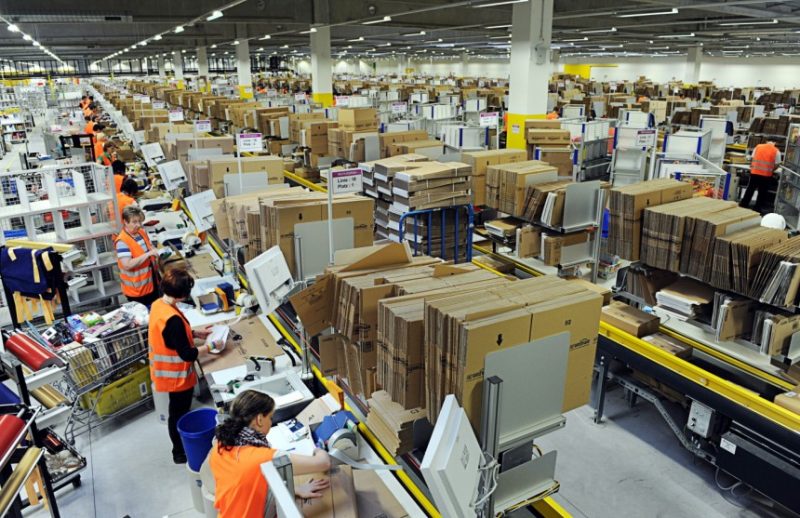Program Used to Track Employees’ Efficiency, Target Them
An investigative story in TheVerge.com describes how AI is being used to fire warehouse workers for failing to meet productivity quotas. The numbers obtained by the website came were from a single facility between August of 2017 and September of 2018, according to the article by Colin Lecher.
A spokesperson for the company said that, over that time, roughly 300 full-time associates were terminated for inefficiency.
The Baltimore facility where the firings took place employees about 2,500 people. Amazon operates more than 75 fulfillment centers with more than 125,000 full-time employees. By extrapolating the numbers, thousands of employees have been fired for not meeting their expectations.
Stacy Mitchell, co-director of the Institute for Local Self-Reliance and a prominent Amazon critic, told The Verge that it’s a dehumanizing system.
“One of the things that we hear consistently from workers is that they are treated like robots in effect because they’re monitored and supervised by these automated systems,” Mitchell says. “They’re monitored and supervised by robots.”
Employees are known to skip bathroom breaks to avoid being penalized by the system, according to Mitchell.
“Amazon produced the data as part of a labor dispute with a former worker at the Baltimore facility, who claimed they had been terminated for engaging in legally protected activity, and filed a complaint with the National Labor Relations Board,” according to The Verge. “In a letter to the board, Amazon responded that the employee had instead been fired for failing to reach productivity benchmarks—a common occurrence, the company said. To bolster its case, the company also included the list of terminations at the Baltimore facility, labeled by Amazon as BWI2. The Verge obtained the letter and related documents through a Freedom of Information Act request.”
A story in Futurism.com on the AI firings called it, “a grim glimpse of a future in which AI is your boss.”
Amazon spokesperson Ashley Robinson responded to the story: “Similar to many companies, we have performance expectations regardless of whether they are corporate or fulfillment center employees,” read the statement. “We support people who do not perform to the levels expected of them with dedicated coaching to help them improve and be successful in their career at Amazon. We would never dismiss an employee without first ensuring that they had received our fullest support, including dedicated coaching to help them improve and additional training. Since we’re a company that continues to grow, it’s our business objective to ensure long-term career development opportunities for our employees.”
Robots have it far better than human employees, according to a story in The Guardian, which published a harrowing account of working in an Amazon fulfillment center, where the employee said he and others felt as though they were treated as “disposable.”
“It doesn’t take long before you’ve seen blown backs, boxes falling on people’s heads, carpal tunnel in your coworkers’ wrists, and balky knees that never get better. You’ve seen workers compensation claims repeatedly denied and efforts to address safety issues given low priority. You’ve seen sexism, racism, and ageism in a promotion culture tainted with favoritism. You’ve seen write-ups unfairly distributed and used to manipulate workers. You’ve seen an emotionally toxic culture, where the stress of meeting productivity targets leads managers to treat workers like things, to be pushed harder and faster without regard for the emotional or personal cost. You’ve arrived home exhausted, too worn out to spend time with your kids or friends. And you’ve noticed that the wealth we produce is being accumulated by our boss – the modern world’s richest man – while our wages barely keep us afloat. Amazon’s much-touted new minimum wage of $15 is not enough to propel hundreds of thousands of us into the middle class.”
Amazon’s “Anonymous” diary keeper also described the warehouse at Christmas time as like “working in a sweatshop firing on all cylinders.” Full-time employees are required to work “mandatory extra-time,” up to 60 hours per week of up to 12 hour days, while part-time workers are encouraged to take as many extra shifts as possible.
“Our workforce doubles with ‘seasonal’ workers who are paid less, not given benefits, and put on a restrictive time-off allowance, ensuring they’ll be working through the holiday season.”
After the Black Friday to Christmas peak season ends, managers fire seasonal employees who didn’t work as many hours as they could have.
“Last year, that was when the culling of seasonal associates began, people fired mid-shift by text message,” Anonymous wrote. “Not an hour later, texts went out seeking volunteers for overtime for the next two weeks. The text was accidentally sent to some of those who had just been fired. One of them, my friend, kicked a pallet over, said ‘fuck this’ and marched out the building. Promises of conversion vanish for some, while others say good riddance and are on their way.”
Aside from the individual complaint, the only group that has organized a protest against the harsh, nonstop conditions is a group of East African Muslim workers who said they were denied enough time to pray during their breaks.








Leave A Comment